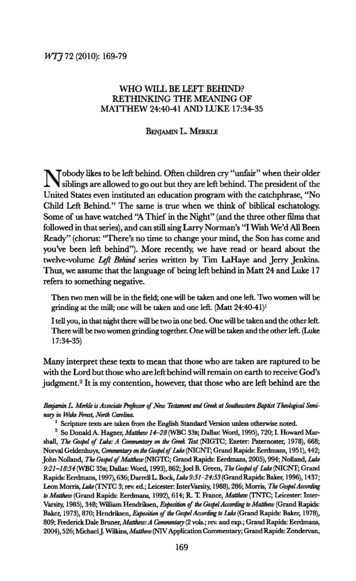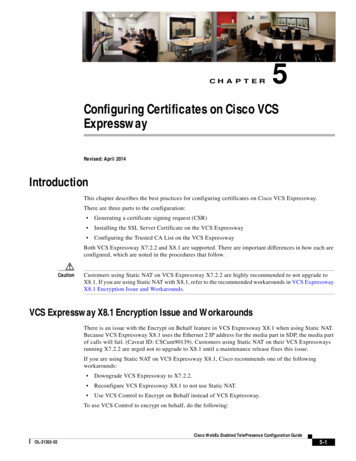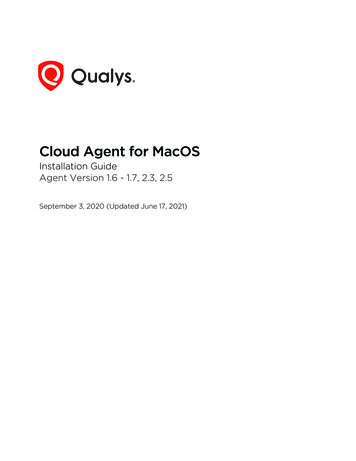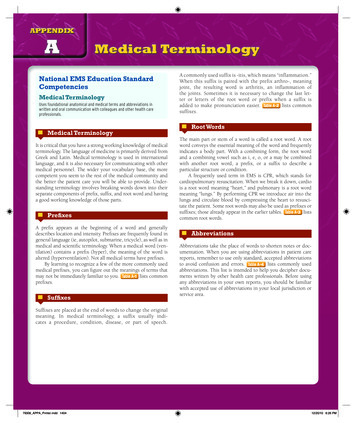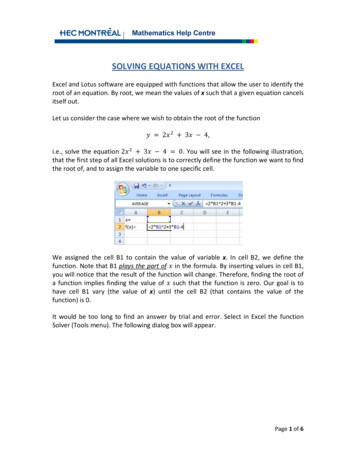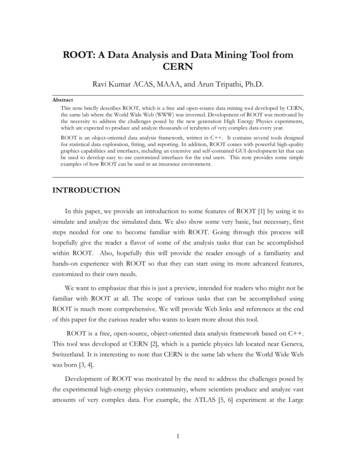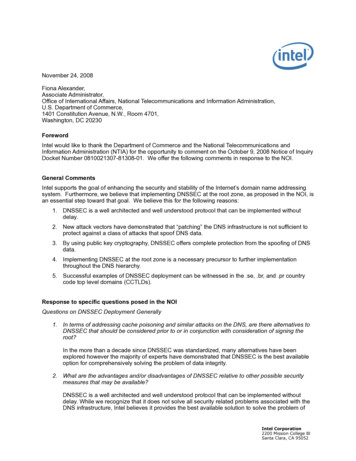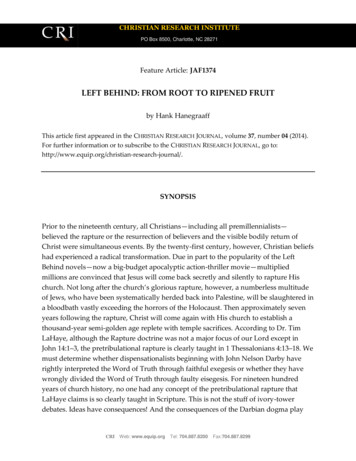
Transcription
CHRISTIAN RESEARCH INSTITUTEPO Box 8500, Charlotte, NC 28271Feature Article: JAF1374LEFT BEHIND: FROM ROOT TO RIPENED FRUITby Hank HanegraaffThis article first appeared in the CHRISTIAN RESEARCH JOURNAL, volume 37, number 04 (2014).For further information or to subscribe to the CHRISTIAN RESEARCH JOURNAL, go /.SYNOPSISPrior to the nineteenth century, all Christians—including all premillennialists—believed the rapture or the resurrection of believers and the visible bodily return ofChrist were simultaneous events. By the twenty-first century, however, Christian beliefshad experienced a radical transformation. Due in part to the popularity of the LeftBehind novels—now a big-budget apocalyptic action-thriller movie—multipliedmillions are convinced that Jesus will come back secretly and silently to rapture Hischurch. Not long after the church’s glorious rapture, however, a numberless multitudeof Jews, who have been systematically herded back into Palestine, will be slaughtered ina bloodbath vastly exceeding the horrors of the Holocaust. Then approximately sevenyears following the rapture, Christ will come again with His church to establish athousand-year semi-golden age replete with temple sacrifices. According to Dr. TimLaHaye, although the Rapture doctrine was not a major focus of our Lord except inJohn 14:1–3, the pretribulational rapture is clearly taught in 1 Thessalonians 4:13–18. Wemust determine whether dispensationalists beginning with John Nelson Darby haverightly interpreted the Word of Truth through faithful exegesis or whether they havewrongly divided the Word of Truth through faulty eisegesis. For nineteen hundredyears of church history, no one had any concept of the pretribulational rapture thatLaHaye claims is so clearly taught in Scripture. This is not the stuff of ivory-towerdebates. Ideas have consequences! And the consequences of the Darbian dogma playCRI Web: www.equip.orgTel: 704.887.8200Fax:704.887.8299
out in the caldron of real life. Darby’s subjective spin on Scripture leads inexorablytoward the nightmarish ending for Jews graphically portrayed in Left Behind theology.One of the most compelling prophetic events in the Bible is called the “rapture” of thechurch. It is taught clearly in 1 Thessalonians 4:13–18, where the apostle Paul providesus with most of the available details.—Tim LaHaye and Jerry B. Jenkins,Are We Living in the End Times?No single verse specifically states, “Christ will come before the Tribulation.” On theother hand, no single passage teaches He will not come before the Tribulation, or thatHe will come in the middle or at the end of the Tribulation. Any such explicitdeclaration would end the debate immediately.—Tim LaHaye, No Fear of the StormGlossaryapocalyptic/apocalypse: (Greek apocalypsis, an unveiling) a literary genre used todescribe prophetic literature composed in the highly metaphorical and symboliclanguage system used within postexilic Judaism and early Christianity. The book ofRevelation is an apocalypse—not just in the sense of an unveiling but in the sense ofwhat might best be described as a language system or matrix that is deeply embeddedin the Old Testament canon. To comprehend Revelation, one must first understand wellthe rest of the Bible.dispensationalism: a system of interpreting the Bible involving a strict literalismaccording to which God has two distinct peoples (the church and national, ethnic Israel)with two distinct plans and two distinct destinies. Dispensationalism (especiallyCRI Web: www.equip.orgTel: 704.887.82002Fax:704.887.8299
dispensational eschatology) is distinctive for its teaching that the church will be“raptured” from the earth in the first phase of Christ’s second coming so that God canreturn to His work with national Israel, which was put on hold after Israel’s rejection ofthe Messiah. God’s renewed working with Israel is thought by many dispensationaliststo include a seven-year period of tribulation under Antichrist in which two-thirds of theJewish people will be killed, followed by the second phase of Christ’s second coming inwhich Christ and the martyred “tribulation saints” will rule for a thousand years from arebuilt temple with a reinstituted sacrificial system. Dispensationalism was firstconceived by John Nelson Darby in the nineteenth century and popularized byprophecy pundits such as Hal Lindsey and Tim LaHaye in the twentieth century.eschatology: (Greek eschatos, meaning “last, farthest,” and logos, “speaking, word”) thestudy of last things or end times. Far from being a mere branch in the theological tree,eschatology is the root that provides life and luster to every fiber of its being. To studyScripture is to study eschatology, for all of God’s work on earth—past, present, andfuture—moves toward eternal redemption. Put another way, eschatology is the threadthat weaves the tapestry of Scripture into a harmonious pattern.exegesis: (Greek exegeisthai, meaning “to explain, interpret, tell,” from ex- “out,” andhegeisthai “to lead, guide”) the method by which an author’s intended meaning isunderstood. In sharp contrast, eisegesis is reading into the biblical text something thatsimply isn’t there.great tribulation: according to many dispensationalists, the great tribulation refers to afuture seven-year period of incomprehensible horror following a secret rapture of thechurch. During this period, two-thirds of the Jewish people will die under the rule of anAntichrist. Biblically, however, the term “great tribulation” refers to the horrificpersecution of Christians by the Beast beginning in AD 64 prophesied in the book ofRevelation (see Rev. 7:14; cf. Matt. 24:21).millennium: a metaphor used by John in Revelation 20:1–10. While some biblicalexegetes interpret “a thousand years” literalistically, those who interpret Scripture inlight of Scripture invariably recognize the number as figurative. For example, Godincreased the number of the Israelites a thousand times (Deut. 1:11); God keeps Hiscovenant to a thousand generations (7:9); God owns the cattle on a thousand hills (Ps.CRI Web: www.equip.orgTel: 704.887.82003Fax:704.887.8299
50:10). (And a thousand more examples—metaphorically speaking—could easily beadded to the list.)Protocols of the Elders of Zion: a thoroughly discredited conspiracy theory in whichsinister Jews secretly scheme to seize global control by destabilizing civil governments,disrupting world economies, and destroying Christian civilization. The Protocolssignificantly stoked the embers of anti-Semitism.rapture: (Latin rapio, meaning “caught up”) this word was used in Latin translations ofthe Bible to express Paul’s teaching that believers living at the time of Christ’s returnwould be “caught up.to meet the Lord in the air” (1 Thess. 4:17). As typically used byevangelical Christians today, however, the word “rapture” communicates the idea of adivine disappearing act in which Jesus Christ secretly returns to earth to take faithfulbelievers out of this world just prior to a seven-year period of great tribulation. Thisunderstanding of rapture is referred to, for obvious reasons, as pretribulational rapture. Ifthe question “Will there be a rapture?” is taken to mean, “Will believers be ‘caught up’to meet the Lord as Paul taught?” the answer is a resounding “yes.” Conversely, if thequestion is “Will there be a pretribulational rapture as described above?” the answer isunambiguously “no.” Far from teaching a pretribulational rapture of the church, theBible teaches that the glorification of believers living at the time of Christ’s return is asingle event that will happen concurrently with the general resurrection of the dead (seeesp. John 5:28–29; 1 Cor. 15; 1 Thess. 4).resurrection: the raising of a body from death to eternal life; used to refer to the generalresurrection of the dead—the just to eternal life and the wicked to eternal separationfrom God—that will occur at the time of Christ’s future bodily return to earth (see John5:28–29; 1 Cor. 15; 1 Thess. 4); also used to refer to Jesus’ resurrection from the dead as“the first-fruits of those who have fallen asleep” (1 Cor. 15:20).ROOTIn 1831—the same year that Charles Darwin left England and sailed into evolutionaryinfamy aboard the HMS Beagle—another nineteenth-century dogma with profoundconsequences for the history of humanity was birthed in the British Isles. That year JohnCRI Web: www.equip.orgTel: 704.887.82004Fax:704.887.8299
Nelson Darby, a disillusioned priest, left the Church of England and joined a separatistmillenarian group called the Plymouth Brethren in the English city of Plymouth.In general, Darby accepted the premillennial perspective of the Brethrenmovement. Like Darwin, however, Darby was a trendsetter. In much the same way thatDarwin imposed a speculative spin on the scientific data he encountered along theSouth American coasts of Patagonia, Darby imposed a subjective spin on the scripturaldata he encountered in the city of Plymouth.Darby contended that God had two distinct people with two distinct plans andtwo distinct destinies. Only one of those peoples—the Jews—would suffer tribulation.The other—the church—would be removed from the world in a secret coming sevenyears prior to the second coming of Christ. Darby’s distinctive twist on Scripture wouldshortly come to be known as dispensational eschatology (an end-times theory destined fortwenty-first-century stardom in the apocalyptic action-thriller Left Behind: The EndBegins starring Nicholas Cage and Chad Michael Murray1).Beginning with Darby, dispensationalists held that due to the murder of theirMessiah, Jews were in for a time of unprecedented suffering variously referred to as thetime of “Jacob’s Trouble” or the “Great Tribulation.”2 Early dispensationalists such asArthur W. Pink and Arno C. Gaebelein underscored the contention that Jews wereunder a “national blood-guiltiness” for “the murder of Christ.”3In Conflict of the Ages, Gaebelein described Jews as “infidels” and “a menace” andcontended, “The greater part of Jewry has become reformed, or as we call it,‘deformed.’”4 Historian Dr. Timothy Weber notes that despite such unguarded remarks,Gaebelein’s The Conflict of the Ages received rave reviews in dispensational oracles suchas Moody Bible Institute’s Moody Monthly and Dallas Seminary’s Bibliotheca Sacra.5In his seminal volume, On the Road to Armageddon, Weber chronicles a formidablelist of dispensational luminaries who were on the vanguard of promoting baseless, antiSemitic conspiracy theories. Some hailed The Protocols of the Elders of Zion as proofpositive that Jews were masterminding a global conspiracy to destroy Christiancivilization.6James M. Gray of Moody Bible Institute called the Protocols “a clinchingargument for premillennialism.”7 And Arno Gaebelein praised Serge Nilus, who firstpublished the Protocols, writing that he “was a believer in the Word of God, inprophecy, and must have been a true Christian.”8 Even after it became painfullyobvious, Gaebelein remained unwilling to acknowledge the Protocols as an outrightforgery and continued to advertise The Conflict of the Ages until his death in 1945.9CRI Web: www.equip.orgTel: 704.887.82005Fax:704.887.8299
Charles C. Cook of the Bible Institute of Los Angeles likewise pronounced theProtocols authentic and stereotypically described the “accompanying traits” of Jews as“pride, overbearing arrogance, inordinate love for material things, trickery, rudenessand an egotism that taxes the superlatives of any language.” In the institute’s magazine,King’s Business, Cook opined that the reason Jewish people were “persona non grata atresorts and in the best society” is that “the unregenerated Jew usually has a veryunattractive personality.”10Such remarks impelled the venerable Harry A. Ironside to say that it grieved him“to find that the Protocols are being used not only by godless Gentiles, but even by somefundamentalist Christians to stir up suspicion and hatred against the Jewish people as awhole.”11 Despite the embarrassment, dispensationalists (including Ironside) persistedin predicting a future period of unprecedented tribulation for Jews.In their view, history hinged on herding Jews back into Palestine where twothirds of them will die in an apocalyptic Armageddon. As dispensational luminary Dr.John Walvoord explains, “Israel is destined to have a particular time of suffering whichwill eclipse anything that it has known in the past.” Walvoord underscored this realityby adding that Jews returning to Palestine were “placing themselves within the vortexof this future whirlwind which will destroy the majority of those living in the land ofPalestine” (emphasis added).12In keeping with Walvoord’s ominous prediction, Hal Lindsey told Christiandevotees that not long after their glorious rapture “a numberless multitude” of Jewswould be slaughtered in a bloodbath that would exceed the horrors of the Holocaust.Lindsey went on to predict that the brutality of the Beast would make the Nazi butchers“look like Girl Scouts weaving a daisy chain.”13For his part, Dr. Tim LaHaye uses biblical monikers such as “The Day of Israel’sCalamity” to codify what he eerily described as Antichrist’s “final solution” to the“Jewish problem.”14 Like Lindsey, he is convinced that this time of national suffering forJews will “be far worse than the Spanish Inquisition of the sixteenth century or even theHolocaust of Adolph Hitler in the twentieth century.”15According to LaHaye, the time of Jewish Tribulation will be a nightmarish realitybeyond imagination: “Take the horror of every war since time began, throw in everynatural disaster in recorded history, and cast off all restraints so that the unspeakablecruelty and hatred and injustice of man toward his fellow men can fully mature, andcompress all that into a period of seven years. Even if you could imagine such a horror,it wouldn’t approach the mindboggling terror and turmoil of the Tribulation.”16CRI Web: www.equip.orgTel: 704.887.82006Fax:704.887.8299
THE HEART OF DISPENSATIONALISMThe early 1800s found a broad range of premillennialists naively seeking to time theapproaching terror and turmoil of the Tribulation with the Second Coming bycorrelating current events with biblical prophecy.17 On the cultic fringe, Mormonfounder Joseph Smith was propagating the notion that his generation was living in thevery shadow of Christ’s return. Smith alleged that God had told him the return ofChrist would take place before he was eighty-five years of age, prompting historianssuch as Ernest Sandeen to characterize Joseph and his contemporaries as beingmetaphorically drunk on the millennium.18In more mainstream premillennial circles, the gifted Baptist orator William Millerwas also circulating the conclusion that his generation was living on the very edge ofthe Millennium. In 1831 he publicly identified the year of Christ’s return as 1843. Usingmillennial mathematics, Miller calculated a day in prophetic parlance as equivalent to ayear in prophetic history. He reckoned that according to Daniel 8:14, exactly 2,300“days” after Artaxerxes’ decree (457 BC), the millennium would commence.Nineteenth-century historic premillennialists used millennial mathematics notonly to date the time of Christ’s descent, but also to determine such details as the timeof the Antichrist’s demise. They began by supposing that the Roman pontiff was theAntichrist depicted in Revelation 13. Furthermore, they speculated that according toRevelation 11, precisely 1,260 “days” after the rise of the Roman papacy (AD 538), thereign of the Beast would come to an abrupt end.Thus, the exile of the Roman pontiff by the French in 1798 was hailed as validation oftheir date-setting prowess.In 1831—the year Miller announced that he had discovered the time of Christ’sreturn—Darby added a unique twist to the dating game by introducing the concept of asecret coming seven years prior to the second coming of Christ. Thus one could onlydetermine the time of Christ’s second coming after the time of Christ’s secret coming.Initially this proved a damper to the dating game. Later dispensationalists such asLaHaye, however, found a variety of new rules to ensure that the dating game couldcontinue to be played. LaHaye demonstrated an unusually fertile imagination byforwarding the notion that the generation who heard the Austrian declaration of WorldWar I in 1914 would not pass away before Christ’s second coming.19While dispensationalism has evolved into the poster child for biblical literalism,the Plymouth Brethren initially exposed to Darby’s unique twist on the text consideredit exegetically indefensible. Thus, Darby’s system of dividing the Bible divided theBrethren.20 The Brethren scholar Samuel P. Tregelles, recognized for his historicalanalysis of the Greek text of the New Testament, dismissed Darby’s eschatologicalCRI Web: www.equip.orgTel: 704.887.82007Fax:704.887.8299
musings as speculative nonsense. In his considered opinion, the sophistry of a secretreturn of Christ, seven years before the second coming of Christ, had its origin in anecstatic utterance in the London congregation of Edward Irving, not in biblical exegesis.As Tregelles put it, “It was from that supposed revelation that the modern doctrine andthe modern phraseology respecting it arose. It came not from Holy Scripture, but fromthat which falsely pretended to be the Spirit of God.”21According to Darby himself, however, his dispensational doctrines originatedneither from an ecstatic utterance in Edward Irving’s London congregation nor from thevision of a Scottish lassie named Margaret MacDonald. Rather, they evolved from thehypothesis that Scripture is replete with two distinct stories concerning two distinctpeople for whom God had two distinct plans.22 Thus, to Darby, reading the Bible for allit is worth meant deciding in advance which Scriptures applied uniquely to Israel andwhich Scriptures applied unequivocally to the church.Premillennialist luminary George Eldon Ladd explained that “this principle hasfrequently been called ‘Rightly dividing the Word of Truth.’ It is the method of deciding inadvance which Scriptures deal with the Church and which Scriptures have to do withIsrael, and then to interpret the passages concerned in the light of this ‘division’ of theWord.”23 B. W. Newton, “one of the earliest and most learned of the Brethren,”however, dubbed Darby’s method the “height of speculative nonsense.”24 C. I. Scofield,who followed Darby as dispensationalism’s quintessential authority for biblicalinterpretation, thought otherwise. In 1888 Scofield published Rightly Dividing the Wordof Truth, which became a primary defense of Darby’s two people of God theory.25In our generation, LaHaye is on the forefront of defending and disseminatingDarby’s “two people” dogma. In fiction and nonfiction, and most recently through thebig budget film Left Behind: The End Begins, LaHaye underscores the nonnegotiablenecessity of dispensationalism’s distinctive doctrine. In his words, “The distinctionbetween Israel and the church is important because the church’s present distinctivenessin the plan of God provides the theological basis for the pretribulation Rapture.”26While LaHaye’s prowess in marketing Darby’s dogma is breathtaking, we mustultimately ask whether it is biblical. Indeed, we must determine whetherdispensationalists beginning with Darby have rightly illumined the Word ofTruth through faithful exegesis or whether they have wrongly divided the Word ofTruth through faulty eisegesis. For nineteen hundred years of church history, no one—including historical luminaries such as Ephraim, Augustine, Calvin, Luther, Knox,Zwingli, and Wesley—had any concept of the pretribulational rapture that LaHayeclaims is so “clearly taught” in Scripture. Were they all biblically blind? Or is it LaHayeand the Left Behind crowd who cannot see?CRI Web: www.equip.orgTel: 704.887.82008Fax:704.887.8299
This is not the stuff of ivory-tower debates. Ideas have consequences! And theconsequences of the Darbian dogma play out in the caldron of real life. Darby’ssubjective spin on Scripture leads inexorably toward the nightmarish endinggraphically portrayed in Left Behind theology. If LaHaye is right, the time of JewishTribulation will indeed be a nightmarish reality beyond imagination.Two Distinct PeopleWe begin by turning our attention to the heart of the dispensational dogma, namely,that God has two distinct peoples—one of whom must be raptured before God cancontinue his plan with the other. In LaHaye’s words, “Jacob had 12 sons, who becamethe heads of the 12 tribes of Israel. They began the Jewish nation, and since then thehuman race has been divided into Jews and Gentiles .Israel began with ‘FatherAbraham’ and will continue as a distinct entity throughout the rest of history”(emphasis added).27One of the ways by which LaHaye distinguishes between these two classes istemperament: “As a student of human temperament for many years, I have beenintrigued by the Jewish temperament. After carefully analyzing the temperament of thefirst Israelite as he is described in the Bible, I have found Jacob to be a ‘dead ringer’ forthe twentieth-century residents of Israel.”28 Therefore, according to LaHaye, the twoclasses can rightly be distinguished and divided on the basis of personal characteristics.The good news for Jews is that LaHaye believes that on the basis of their race,they have a divine right to the land of Palestine. The bad news is that, as a direct resultof the crucifixion of Christ, twenty-first-century Jews will soon die in an Armageddonthat will make the Nazi Holocaust pale by comparison. So, before “all Israel will besaved” (Rom. 11:26), a majority of Jews must be slaughtered.According to The End Times Controversy, edited by LaHaye, when Jacob’sdescendants rejected and crucified Christ, they suffered two distinct consequences. Thefirst consequence was that “the flock of Israel was dispersed.” The second consequencewill be “the death of two-thirds of the flock. This will be fulfilled during the GreatTribulation when Israel will suffer tremendous persecution (Matthew 24:15–28;Revelation 12:1–17). As a result of this persecution of the Jewish people, two-thirds aregoing to be killed.”29Does the illumination of Scripture reveal that God has two categories of people,one that will be raptured, the other ravaged? Or does Scripture reveal only one chosenpeople who form one covenant community, beautifully symbolized by the apostle Paulas a single cultivated olive tree?CRI Web: www.equip.orgTel: 704.887.82009Fax:704.887.8299
First, far from communicating that God has two distinct peoples, the Scripturesfrom beginning to end reveal only one chosen people purchased “from every tribe andlanguage and people and nation” (Rev. 5:9).30 As Paul explains, the “mystery is thatthrough the gospel the Gentiles are heirs together with Israel, members together of onebody, and sharers together in the promise in Christ Jesus” (Eph. 3:6).Indeed, the precise terminology used to describe the children of Israel in the OldTestament is ascribed to the church in the New Testament. Peter calls them “a chosenpeople, a royal priesthood, a holy nation, a people belonging to God, that you maydeclare the praises of him who called you out of darkness into his wonderful light. Onceyou were not a people, but now you are the people of God” (1 Pet. 2:9–10, emphasisadded). Ultimately, they are the one chosen people of God, not by virtue of theirgenealogical relationship to Abraham, but by virtue of their genuine relationship to “theliving Stone—rejected by men but chosen by God” (1 Pet. 2:4). The true church is trueIsrael, and true Israel is truly the church.Further, just as the Old and New Testaments reveal only one chosen people, sotoo, they reveal only one covenant community. While that one covenant community isphysically rooted in the offspring of Abraham—whose number would be like that of“the stars” of heaven (Gen. 15:5) or “the dust of the earth” (Gen. 13:16)31—it isspiritually grounded in one singular Seed. Paul makes this explicit in his letter to theGalatians: “The promises were spoken to Abraham and to his seed. The Scripture doesnot say ‘and to seeds,’ meaning many people, but ‘and to your seed’ meaning oneperson, who is Christ” (Gal. 3:16). As Paul goes on to explain, “If you belong to Christ,then you are Abraham’s seed, and heirs according to the promise” (v. 29).To suggest that Israel must “fulfill her national destiny as a separate entity afterthe Rapture and Tribulation and during the Millennium”32 is an affront to the One Seedin whom all the promises made to Abraham have reached their climax. As KeithMathison has well said, “The promises made to literal, physical Israelites were fulfilledby a literal, physical Israelite, Jesus the Messiah. He is the Seed of Abraham” (emphasisin original).33 The faithful remnant of Old Testament Israel and New TestamentChristianity are together the one genuine seed of Abraham and thus heirs according tothe promise. This remnant is not chosen on the basis of religion or race but rather on thebasis of relationship to the resurrected Redeemer. Clothed with Christ, men, women,and children in every age and from “every tongue and tribe and nation”34 form one andonly one covenant community.Finally, the one chosen people, who form one covenant community, arebeautifully symbolized in the book of Romans as one cultivated olive tree (see Rom.11:11–24). The tree symbolizes national Israel, its branches symbolize those who believe,and its root symbolizes Jesus—“the Root and the Offspring of David” (Rev. 22:16).CRI Web: www.equip.orgTel: 704.887.820010Fax:704.887.8299
Natural branches broken off represent Jews who reject Jesus. Wild branches grafted inrepresent Gentiles who receive Jesus. Thus, says Paul, “Not all who are descended fromIsrael are Israel. Nor because they are his descendants are they all Abraham’schildren .In other words, it is not the natural children who are God’s children, but it isthe children of the promise who are regarded as Abraham’s offspring” (Rom. 9:6–8).Jesus is the one genuine seed of Abraham! And all clothed in Christ constituteone congruent chosen covenant community connected by the cross. “There is neitherJew nor Greek [Arab or Armenian, American or African, Australian or Asian, etc.], slavenor free, male nor female, for you are all one in Christ Jesus. If you belong to Christ,then you are Abraham’s seed, and heirs according to the promise” (Gal. 3:28–29).In the end, there simply is no biblical warrant for the dispensational notion thatGod has two distinct people. And if God has always had only one people, thedispensational dogma that God has two distinct plans for these two distinct peoplescollapses under the weight of Scripture.Two Distinct PlansJust as there is one chosen people who form one covenant community characterized inScripture by one cultivated olive tree, so too there is only one distinct plan for whatEphesians 2:15 characterizes as “the one true humanity” of God. The pretext that Godpostponed the original plan for Israel and initiated a parenthetical plan for the churchthat abruptly ends with a pretribulational rapture entirely misses the point.First, far from the dispensational postponement of God’s original plan for Israel,Scripture reveals the distinct progression of the divine plan to establish through Israel anew humanity (Eph. 2:15) in a new homeland (Rom. 4:13; Heb. 12:18, 22). From Adam’srebellion to Abraham’s Royal Seed, the Scriptures chronicle God’s one unfolding planfor the redemption of humanity. Far from a postponement in God’s plans because theJews crucified Jesus, Scripture reveals the fulfillment of God’s plans in the crucifixion.For only through faith in Christ’s death and His subsequent resurrection can God’s onecovenant community find rest from their wanderings (Heb. 4:1–11). In Christ—“the lastAdam” (1 Cor. 15:45)—God’s promises find ultimate fulfillment. As Paul so elegantlyput it, “If you belong to Christ, then you are Abraham’s seed, and heirs according to thepromise” (Gal. 3:29).Further, as there is no dispensational postponement in the plan of God, so toothere is no parenthesis in the purposes of God. The pretext for a parenthesis duringwhich there is a postponement in God’s plans for Israel and the commencement of aplan for a church age is the product of a peculiar reading of prophecy. The main focusCRI Web: www.equip.orgTel: 704.887.820011Fax:704.887.8299
of the dogma is Daniel. As LaHaye explains, “It is impossible to understand Bibleprophecy without understanding the book of Daniel. Much of the information about thekey players and the time sequence of the last days is given in Daniel.”35 Of particularnote is Daniel’s “seventy weeks” (Dan. 9:24–27).To expound on the “key players” and “time sequence,” LaHaye reads a numberof presuppositions into Daniel’s seventy weeks. First, he infers a gap of two thousandyears between Daniel’s sixty-ninth and seventieth weeks. Furthermore, he injects intothe gap of two thousand years a “parenthetical period” he calls the “Church Age.”36Finally, he imagines that “the church was an unrevealed mystery in the Old Testament(Rom. 16:25–26; Eph. 3:2–10; Col. 1:25–27)” and that “Israel, and not the church, will fulfillher national destiny as a separate entity after the Rapture and Tribulation and duringthe Millennium” (emphasis added).37As should be self-evident, this invention is not the product of the faithfulinterpretation of the biblical text, but is the by-product of a fertile imagination. The verynotion that the Old Testament prophets did not see “The Valley of the Church,”38 which“did not exist before its birth at Pentecost” and “will come to an abrupt end at theRapture,”39 is flatly false. The Old Testament prophets not only saw the “Valley o
toward the nightmarish ending for Jews graphically portrayed in Left Behind theology. One of the most compelling prophetic events in the Bible is called the rapture of the church. It is taught clearly in 1 Thessalonians 4:13 .18, where the apostle Paul provides us with most of the available de

